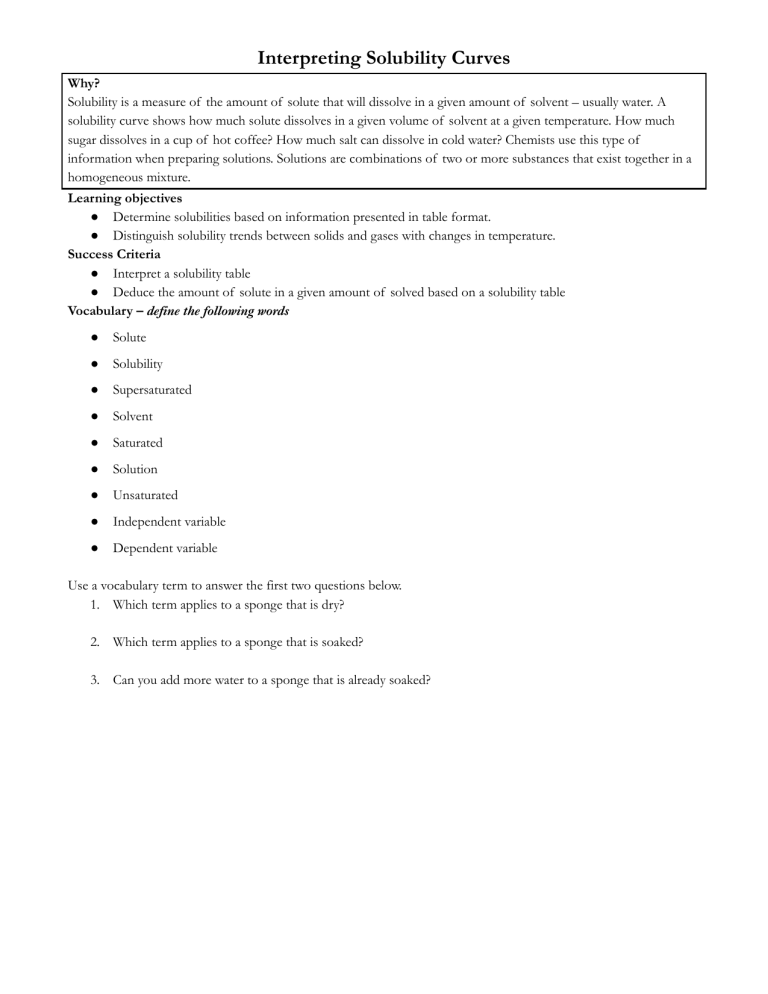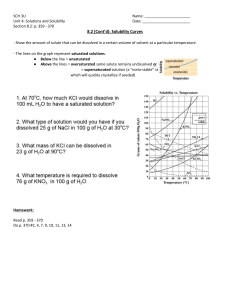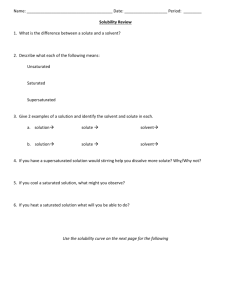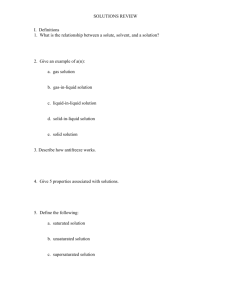
Interpreting Solubility Curves Why? Solubility is a measure of the amount of solute that will dissolve in a given amount of solvent – usually water. A solubility curve shows how much solute dissolves in a given volume of solvent at a given temperature. How much sugar dissolves in a cup of hot coffee? How much salt can dissolve in cold water? Chemists use this type of information when preparing solutions. Solutions are combinations of two or more substances that exist together in a homogeneous mixture. Learning objectives ● Determine solubilities based on information presented in table format. ● Distinguish solubility trends between solids and gases with changes in temperature. Success Criteria ● Interpret a solubility table ● Deduce the amount of solute in a given amount of solved based on a solubility table Vocabulary – define the following words ● Solute ● Solubility ● Supersaturated ● Solvent ● Saturated ● Solution ● Unsaturated ● Independent variable ● Dependent variable Use a vocabulary term to answer the first two questions below. 1. Which term applies to a sponge that is dry? 2. Which term applies to a sponge that is soaked? 3. Can you add more water to a sponge that is already soaked? Model - 1 Table 1. Solubility Data Temperature (oC) Solute (g) per 100g H2O(l) 10 33 30 42 50 52 70 62 90 73 Task Complete the model: Using the grid below make a graph of the solubility data in Table 1. a) Labe x-axis, y-axis and create appropriate scales for each. b) Plot points using a pencil Questions 1. What information is provided by the data in Table 1? 2. What is the relationship between temperature and solubility for this solute? 3. What will happen to this solute when 12 g is added to 100g of water at 20oC? 4. What type of solution is obtained when 12 g of this solute is added to 100 g of water at 20oC (unsaturated, saturated, or supersaturated)? 5. At 20oC, what is the maximum amount of this solute that can be dissolved in 100 g of water? 6. What type of solution is obtained when the maximum amount of a solute is dissolved in water (unsaturated, saturated, or supersaturated)? 7. At 20oC, 50 g of this solute is added to 100 g of water, what will happen to the extra solute? 8. What type of solution is obtained under the conditions in Question #7(unsaturated, saturated, or supersaturated)? Model 2 Use Table G to answer the following questions. 1. Compare the graph that you constructed from the data in Table 1 to graphs in Table G. Which of the solutes in table G is the solute in your graph? 2. Identify the substance in Table G that is most soluble at 60oC. 3. Identify the substance in Table G that is least soluble at 60oC. 4. Identify and state the difference between the solubility curves for ammonia and sodium nitrate. Note that ammonia is a gas and sodium nitrate is a solid at room temperature. 5. Use the temperature dependence of solubility to identify whether the substances in table G are gases or solids. Make two lists below, one for gases and one for solids. 6. Suggest a reason why solubility decreases with increasing temperature for gaseous solutes but increases for solid solutes. Model 3 There are three main factors that affect rate of solution (how fast something dissolves). Increasing temperature increases the rate of solution because it increases the kinetic energy and motion of the particles. Agitating the solution increases rate of solution because it brings fresh solvent in contact with the solute. Smaller particle sizes increases rate of solution because there is a larger overall surface area for solvent to come in contact with. Temperature is the only factor that increases the amount of solute that can be dissolved in the solution. 1. Circle which conditions that would lead to the most saturated sweet tea solution. a. Stirring the tea while adding sugar or pouring sugar in and letting it sit b. Using 2g of sugar cubes or 2 g of granulated sugars c. or hot tea Adding sugar to cold tea 2. What factor is changing in #1a? 3. What factor is changing in #1b? 4. What factor is changing in #1c? ©POGIL, 2005 Authored by E. Graham and R. McGrath, Modified by L. Trumminello, R. Quackenbush K. Levy and K. levy; Edited by Linda Padwa and David Hanson, Stony Brook University.





